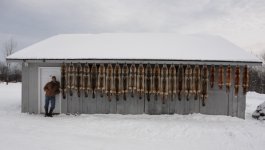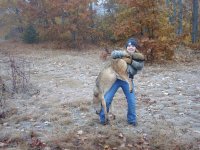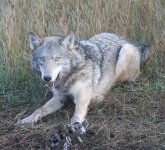This is from an ongoing study that is not yet complete.
Experts surprised by which predator is No. 1 killer of deer in Michigan's Upper Peninsula | MLive.com
By Howard Meyerson | The Grand Rapids Press
Published: Monday, April 02, 2012, 8:00 AM
ESCANABA — Michigan hunters have been known to say that state’s growing wolf population is bad for deer. Their lament is about the diminished Upper Peninsula whitetail population. It’s not unusual to hear someone claim: “Wolf are eating all the deer.”
But what researchers found this past winter, the third year of a western U.P. deer mortality study, is that coyotes were the No. 1 predator followed by bobcats. Wolves came in fourth after a three-way tie among hunters, unknown predators and undetermined causes.
“I was somewhat surprised to see coyotes play as large a role in fawn predation as they did...,” said Jerry Belant, an associate professor of Wildlife Ecology and Management at Mississippi State University. Belant oversees student researchers who are working in partnership with the Michigan Department of Natural Resources. He said coyotes were more prevalent than expected. There were also few rabbits and hares to feed upon.
Researchers got their data from 142 fawns fitted with GPS collars. The devices transmitted their location every 15 minutes. Eighty collared fawns died during the three year first phase of the study. Predators killed 73 percent of the deer.
The study aims to identify just what is killing UP deer. Phase 1 took place in a region known for “low snow” depths. Phase 2 and 3 will look at mid- and high-snow zones.
“We wanted to look at the role of predation and winter habitat on fawn survival,” said Dean Beyer, a wildlife researcher with Michigan’s DNR.
Agency staff have long said that wolves play a small role in deer mortality. Biologists estimate the UP deer population at 270,000. Cars and hunters kill roughly 64,000. Wolves kill 17,000 to 29,000 deer. An estimated 687 gray wolves live in the Upper Peninsula, according to the DNR’s website.
“We jumped into the UP because of the deer population trends,” Beyer said. “The herd did well in the early '90s. Then we had two severe winters back to back (in the mid 90s) and the population dropped and stayed flat and hasn’t rebounded.
“Winter weather is a driver up there. Lake Superior is a snow making machine. It creates deep snows close to the lake and the snow depths decline as you move away.”
Severe UP winters can kill 30 percent or more of the deer population. So researchers collared both fawns and predators. The GPS data was plotted on a map. When a cluster appeared, students went out to the site to see what they could find.
Belant and Beyer discovered two packs of wolves in the area. But they also found something else: nine livestock pits where farmers dumped dead cattle.
“They (wolves) were hitting carcasses,” Beyer said. “That influenced the predation on fawns and might have reduced it. It will be interesting to see what happens in the mid-snow zone where there is no agriculture or cattle dump.”
Phase 2 begins next winter in Iron County, Phase 1, in Delta and Menominee counties, collected predator data points for 650,000 locations, Beyer said.
“We’re pretty pleased with how things worked out. The one thing that surprised us a little was finding that bobcats were very efficient predators. Their kill rate was higher than we expected.”
Wolves, on the other hand, were expected to score higher. That they didn’t has researchers wondering what will show up next year.
Brent Rudolph, the DNR’s deer program manager, said he expects wolves will play a bigger role in deer predation.
“We went into an area not as heavily used by wolves,” he said. “As we shift study sites into areas with more wolves there will be more wolf mortality. Coyotes won’t be as effective in those areas because wolves will outright exclude coyotes on the kill.”
It is fair to say that having wolves on the landscape stirs emotions for many. Wolves are feared, reviled and revered; the root of all that would take up another column — maybe two.
So let me say I am glad to see this study moving forward. The first phase results are enlightening. The rest will tell us what we need to know.


